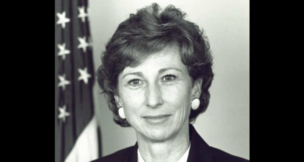Sharlot Hall
Arizona Capitol Reports Staff//May 20, 2005//[read_meter]
In 1927, three years before this photograph was taken, Sharlot Hall negotiated a contract to lease the old Governor’s Mansion in Prescott. Built of massive logs from nearby stands of ponderosa pine, the eight-room structure was completed over a three-month period during 1864. The spacious structure was used by Governor John N. Goodwin as both his home and an administrative center until 1867, when the territorial capital was moved to Tucson.
After the government moved south, the building remained a center of community life for many years. Later on, it became a neglected and deteriorating rental property. In 1928, Hall rescued the mansion, appropriating space as living quarters and using the remainder of the building to house her large collection of Arizona artifacts. It was opened to the public as the Old Governor’s Mansion Museum. Hall, who was a tireless collector and preserver of frontier history, nurtured the museum through the remainder of her life.
Hall was 12 years old when, in 1882, her family migrated from Lincoln County, Kansas to Lynx Creek near Prescott Valley. The family raised horses, and her father worked in a gold mining operation.
In 1890, Mr. Hall homesteaded a ranch near the junction of Lynx Creek and the Agua Fria River east of Prescott. Apple and pear trees were planted, and the spread was called Orchard Ranch. The Hall’s grew vegetables, kept cows and pigs, and lived in rural isolation. Four miles from their home was a log-adobe schoolhouse where Sharlot spent two terms. She also spent a year in a boarding school in Prescott. Over the next thirty-seven years, Sharlot called Orchard Ranch her home.
At Prescott, she became acquainted with Henry Fleury, a gruff, gray-bearded man who had come to Prescott in 1864 as Governor Goodwin’s secretary. His stories of the territory’s early days stimulated Hall’s interest in Arizona history.
Hall had a passion for writing and in 1891, at the age of 21, she published her first short story. She was paid $4. Over the years, she published more than 500 articles, stories and poems, and two poetry collections became books. Arizona and its history figured prominently in her published work.
In 1906, Hall toured the territory gathering opposition to a congressional measure that would admit New Mexico and Arizona to the Union as a single state. She wrote a 64-page article for Out West Magazine, lauding Arizona’s resources, and her poem “Arizona,” which explained why Arizona should be a separate state, was given to every member of Congress. It is likely that her effort played a role in the bill’s defeat.
In 1909, Hall became the first women to hold a territorial office when she was appointed territorial historian. In her official capacity, she visited prehistoric ruins on reservations and participated in a ten weeklong wagon trip across the remote Arizona Strip north of the Grand Canyon. Her tenure as historian ended when statehood was granted in February 1912.
Hall lived out her life as a single and proudly independent woman. When she died in 1943, her legacy was carried on through the Old Governor’s Mansion Museum. Today it is called the Sharlot Hall Museum, one of the state’s preeminent repositories of historic material.
—W. Lane Rogers. Photo courtesy the author.

















